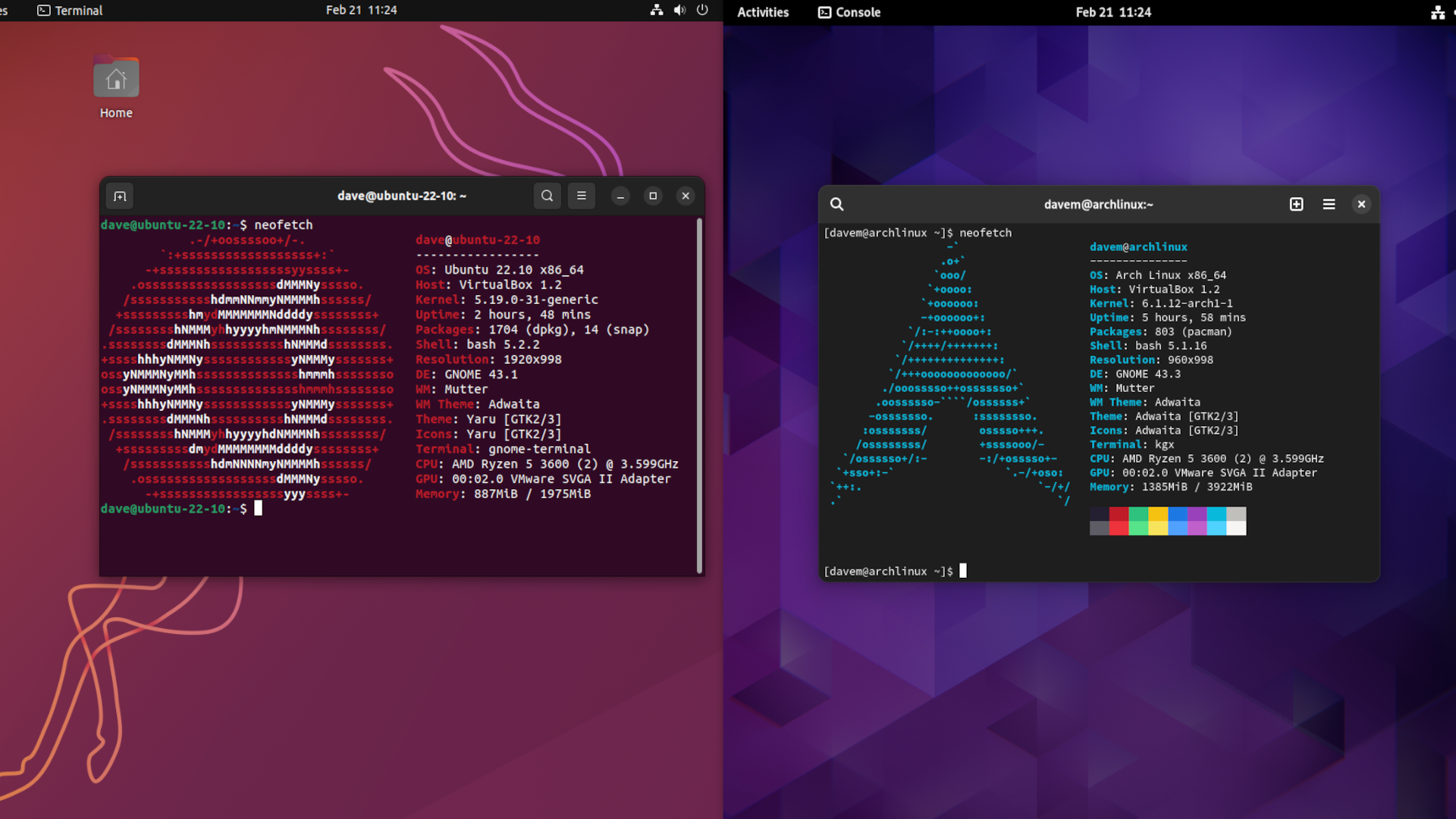Arch Linux vs. Ubuntu LTS: A Long-term Stability Challenge

In the realm of Linux distributions, Arch Linux and Ubuntu LTS (Long Term Support) stand out as contrasting approaches to system management. While both distributions offer robust capabilities, their philosophies diverge significantly when it comes to stability and maintenance.

Arch Linux: Rolling Release, Bleeding Edge

Arch Linux is renowned for its rolling release model, which continuously updates the system with the latest software versions. This approach ensures users always have access to the most up-to-date packages and features. However, it also comes with the potential for instability due to frequent updates, which may introduce unforeseen bugs or conflicts.
Ubuntu LTS: Stable Foundation, Predictability
Ubuntu LTS, on the other hand, adopts a more conservative Long Term Support strategy. Every two years, a new LTS release is published, supported with security and maintenance updates for the following five years. This extended support period prioritizes stability and predictability, minimizing the risk of disruptive updates.
Stability Considerations
The rolling release model of Arch Linux provides an exhilarating experience for users who value the latest features and cutting-edge technology. However, it requires a willingness to embrace potential instability and the need for vigilant system monitoring.
In contrast, Ubuntu LTS excels at providing a stable foundation for mission-critical applications or environments where reliability is paramount. Its extended support period ensures a consistent and secure operating system without the constant worry of disruptive updates.
Maintenance and User Contribution
Arch Linux heavily relies on its user community for bug reporting, fixes, and package maintenance. This model fosters a sense of ownership and collaboration among users, who actively contribute to the distribution’s development.
Ubuntu LTS, while also supported by a large community, has a more centralized approach to maintenance. The Ubuntu Core team oversees major updates and security patches, ensuring a consistent experience for users.
Audience and Use Cases
Arch Linux is ideal for advanced Linux users who demand the latest software and are willing to invest time in system maintenance. It is often used by developers, enthusiasts, and those seeking a customizable and cutting-edge Linux experience.
Ubuntu LTS is well-suited for enterprises, businesses, and users who prioritize stability and reliability over constant updates. It provides a solid foundation for servers, workstations, and environments where uptime and consistency are essential.
Conclusion
Arch Linux and Ubuntu LTS represent two distinct approaches to Linux distribution management. Arch Linux offers a rolling release model with cutting-edge features but potential instability, while Ubuntu LTS prioritizes stability and predictable support with its long-term releases. The choice between them depends on the user’s preference for stability, maintenance workload, and the specific use case for which the system is intended.## Arch Linux Vs. Ubuntu LTS: A Long-term Stability Challenge
Executive Summary
Arch Linux and Ubuntu LTS are two popular Linux distributions that offer different approaches to stability and updates. Arch Linux is a rolling release distribution, which means that it is constantly updated with the latest software. Ubuntu LTS is a long-term support distribution, which means that it is only updated with security and bug fixes for a period of five years.
In this article, we will compare Arch Linux and Ubuntu LTS in terms of their stability, updates, ease of use, and community support. We will also provide a recommendation for which distribution is best for different users.
Introduction
Linux is a free and open-source operating system that has become increasingly popular in recent years. There are many different Linux distributions available, each with its own strengths and weaknesses. Two of the most popular Linux distributions are Arch Linux and Ubuntu LTS.
Arch Linux is a rolling release distribution, which means that it is constantly updated with the latest software. This can be a major advantage for users who want to have the latest and greatest software, but it can also be a disadvantage for users who prefer stability.
Ubuntu LTS is a long-term support distribution, which means that it is only updated with security and bug fixes for a period of five years. This can be a major advantage for users who prefer stability, but it can also be a disadvantage for users who want to have the latest and greatest software.
Stability
Arch Linux is a rolling release distribution, which means that it is constantly updated with the latest software. This can be a major advantage for users who want to have the latest and greatest software, but it can also be a disadvantage for users who prefer stability.
Ubuntu LTS is a long-term support distribution, which means that it is only updated with security and bug fixes for a period of five years. This can be a major advantage for users who prefer stability, but it can also be a disadvantage for users who want to have the latest and greatest software.
In general, Ubuntu LTS is more stable than Arch Linux. This is because Ubuntu LTS is only updated with security and bug fixes, while Arch Linux is updated with new software as well. However, it is important to note that both Arch Linux and Ubuntu LTS are very stable distributions.
Updates
Arch Linux is a rolling release distribution, which means that it is constantly updated with the latest software. This can be a major advantage for users who want to have the latest and greatest software, but it can also be a disadvantage for users who prefer stability.
Ubuntu LTS is a long-term support distribution, which means that it is only updated with security and bug fixes for a period of five years. This can be a major advantage for users who prefer stability, but it can also be a disadvantage for users who want to have the latest and greatest software.
In general, Arch Linux receives more updates than Ubuntu LTS. This is because Arch Linux is updated with new software as well as security and bug fixes, while Ubuntu LTS is only updated with security and bug fixes.
Ease of Use
Arch Linux is a relatively difficult distribution to install and use. This is because Arch Linux is a very minimalist distribution that does not come with a lot of pre-installed software. Ubuntu LTS is a much easier distribution to install and use. This is because Ubuntu LTS comes with a lot of pre-installed software and has a more user-friendly interface.
In general, Ubuntu LTS is easier to use than Arch Linux. However, it is important to note that Arch Linux can be customized to be more user-friendly.
Community Support
Arch Linux has a very active community of users and developers. This means that there is a lot of help and support available for Arch Linux users. Ubuntu LTS also has a very active community of users and developers. However, the Ubuntu LTS community is not as large as the Arch Linux community.
In general, Arch Linux has a more active community than Ubuntu LTS. However, it is important to note that both Arch Linux and Ubuntu LTS have very active communities.
Conclusion
Arch Linux and Ubuntu LTS are both excellent Linux distributions. However, they offer different approaches to stability and updates. Arch Linux is a rolling release distribution that is constantly updated with the latest software. Ubuntu LTS is a long-term support distribution that is only updated with security and bug fixes for a period of five years.
In general, Ubuntu LTS is more stable than Arch Linux. However, Arch Linux receives more updates than Ubuntu LTS. Ubuntu LTS is easier to use than Arch Linux. However, Arch Linux has a more active community than Ubuntu LTS.
The best distribution for a particular user will depend on their individual needs. Users who prioritize stability should choose Ubuntu LTS. Users who prioritize the latest and greatest software should choose Arch Linux.
Keyword Phrase Tags
- Arch Linux
- Ubuntu LTS
- Rolling release
- Long-term support
- Stability
- Updates
- Ease of use
- Community support

Arch Linux and Ubuntu are generally aimed toward distinct audiences entirely and judging solely in terms of stability is counterproductive.
(|_/) /
( o ) we cant talk about only long-term stabiity, Arch is updated approximately every 2 weeks and that breaks things very often.
Well, as an a Average user i find out that you just need to install Arch Linux and use a goodt DE that have all software that you want in one click in GUI mode like pamac in manjaro.
I installed Arch, but dependences its not good.
Ubuntu is definitively the most stable of the two.
i have used both distros and prefer Ubuntu because its very stable. Arch is not stable at all and i dont have enought time to keep fixing it every week.
Howdy folks! If you want a rolling release Arch is your best option, if you’re scared of change stick to Ubuntu LTS.
i think your point its not valid, because Arch Linux is made for users that don’t need a stable
Arch is a great choice for advanced users who want to customize their system and don’t mind the occasional breakage. Ubuntu LTS is a better option for users who want a stable and reliable system that just works.
Sure et tu bro, yes, if you want a stable distro go for debian and derivated like Ubuntu, but if you want to be a gamer and play with you hardware give a try to Arch Linux.
…